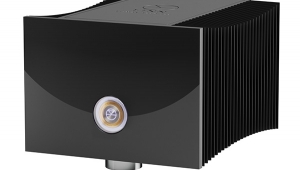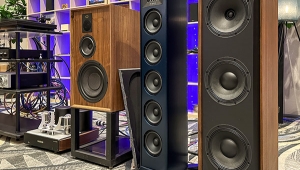| Columns Retired Columns & Blogs |
Celestion SL700 loudspeaker Page 5
Conclusion
It is no secret that the Celestion SL700 was the result of the joint efforts of consultant and reviewer Martin Colloms, Celestion's chief designer Graham Bank (freshly returned from Wharfedale), and the drive-unit design skills of Celestion's Bob Smith, who managed the project team and was responsible for the tweeter, and Ed Form, now no longer with the company but with Tannoy. I remember Martin telling me two years ago that one of the design aims was to try to solve what they felt to be the SL600's problems but without losing its intrinsic musicality. Well, in my opinion, they have succeeded. The SL700 equals the performance of the earlier speaker in the areas where it excels and exceeds it in bass quality, dynamic range, and treble balance. It is perhaps even better in the ability to present images with depth, and is never unmusical. Yes, it does not present a true degree of low bass, but the bass quality is among the best I have heard.
It is no secret that the Celestion SL700 was the result of the joint efforts of consultant and reviewer Martin Colloms, Celestion's chief designer Graham Bank (freshly returned from Wharfedale), and the drive-unit design skills of Celestion's Bob Smith, who managed the project team and was responsible for the tweeter, and Ed Form, now no longer with the company but with Tannoy. I remember Martin telling me two years ago that one of the design aims was to try to solve what they felt to be the SL600's problems but without losing its intrinsic musicality. Well, in my opinion, they have succeeded. The SL700 equals the performance of the earlier speaker in the areas where it excels and exceeds it in bass quality, dynamic range, and treble balance. It is perhaps even better in the ability to present images with depth, and is never unmusical. Yes, it does not present a true degree of low bass, but the bass quality is among the best I have heard.
(While you might think it an excellent candidate for use with a subwoofer—Celestion's System 6000, for example, would seem to be ideal—Celestion advises against it, on the grounds that the compromises necessary to cross over to a subwoofer will reduce the integrity and purity of the upper-bass response.)
However, even considering that the price includes excellent stands, it could be argued that $3000 is a lot of money for a small box loudspeaker.
It is.
But what alternatives are there? The MartinLogan CLS, Quad ELS-63, Thiel CS3.5, and Apogee Duetta are close in price. Of the four, the Quad is the closest in resolving power and neutrality of tonal balance. But it won't play as loud as the SL700, has less good LF extension and bass quality, and, with suitable stands, costs $750 more. The CLS exceeds the SL700 in its ability to analyze a recording, but has an under-damped bass with less extension than the Celestion and, in my opinion, can often be a little too ruthless for its own good. The Thiel is less transparent than the British speaker throughout the audio range, and has an unforgiving high end. However, it has much better bass extension and can play much louder. The Apogee has a less neutral balance than the other four speakers, and makes extreme demands on the matching power amplifier. It has the lowest bass extension of the group, however, as well as perhaps the best midrange quality, and is possibly consistently the most musical.
I suggest, therefore, that even at $3000, in this context the SL700 can be seen to be a contender, a true high-end loudspeaker that, while unable to compete with the very largest speakers in the ability to present the true scale of live music, does present a unique balance of performance unobtainable elsewhere. (To be honest, Celestion's own '600 and the Acoustic Energy AE1 do come close, at nearly two-thirds the price when stands are included. And don't forget Monitor Audio's R952/MD. Or even the Epos ES14.) The box speaker that closest approaches the '700's balance of virtues and offers true low-bass extension is Lewis Lipnick's beloved B&W 801 Matrix, but that costs almost $5000. The SL700, therefore, can be highly recommended, particularly to the pure in heart.
Overall Thoughts
What a month's reviewing! First to hear the Acoustic Energy speakers and be bowled over by them, then to hear the Celestion SL700s perform as well as the smaller speaker in most areas and better in some, and to have a better defined, more extended bass. I then visited Gordon's listening room and was exposed to the $10,000 Infinity IRS Betas—an awesome experience indeed, particularly when listening to my own tapes! I was immersed in both the sound and the performance in a manner that I rarely have been before from reproduced music.
But, thinking rationally about the experience, as much as I was impressed by the Betas' neutrality, LF extension, and dynamics, and the way they added to the musical experience, this is not relevant to my own listening environment. My 19½' x 16' room is just not big enough to accommodate the IRS Beta's four towers and allow me to sit the requisite 10' or so back. Its 20Hz bass extension might also prove to be a problem in that it would excite room resonances to a greater extent than would a smaller speaker. For those of us with relatively small rooms, therefore, I suggest that a well-balanced minimonitor, driven by high-quality electronics, is the best choice. Of the speakers I reviewed in this issue, the Acoustic Energy and the Celestion can be recommended as being sufficiently good in nearly all other areas of performance that their absolute lack of bass can (almost) be ignored.
- Log in or register to post comments




































